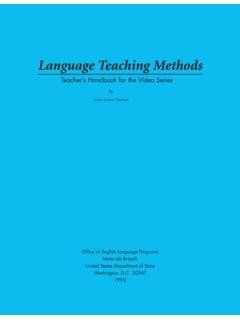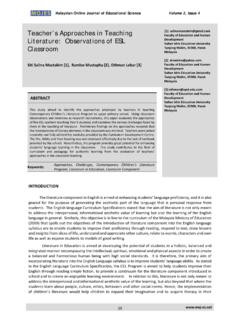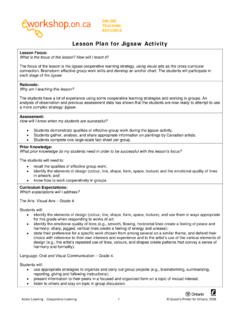Transcription of BE A MANNERS DETECTIVE - FREE Manners Lesson
1 A Good Apple Lesson A Good Apple Lesson A MANNERS Lesson for Children Ages 4-7 INSTRUCTOR GUIDE AND PARTICIPANT WORKSHEETSBE A MANNERS DETECTIVEGood Apple Guide to MANNERS for Kids - Children Ages 4-7 Instructor Guide In Good Company, a division of COCC, 2008. Adapted and used with permission from the Civility Group Good Company extend a special thank you to Paula Wilhelm of Paula is an In Good Company affiliate and passionate advocate of MANNERS for children. We appreciate her ongoing enthusiasm, support and contribution to the Mad About MANNERS project. Thank you as well to Louise Fox who contributed the Etiquette Tips for Children section at the end of this book. Instructor s Note:1. For children ages three and four some of the Lesson activities that require printing or reading will not be appropriate.
2 In these instances, we suggest reading from the Courtesy For Kids Series, doing group activities, role playing, watching videos, putting on puppet shows, making crafts, or doing other activities rather than completing worksheets. 2. For every Lesson , simply discussing the Knowledge material should take 10 minutes. The instructor then has the option to extend the Lesson up to one hour by choosing to do worksheets and other suggested activities. 3. We anticipate that Instructors will need to adapt materials, formats and even approach, depending on the age of participants and teaching scenario. We encourage you to use your imagination. 4. The lessons are listed in such a way that they build on each other. We suggest that Instructors proceed through the lessons in order.
3 Or, choose complete sections and begin with the first Lesson in that section, Table MANNERS Eat, Drink and be Wary, Lessons 11-16. Good Apple Guide to MANNERS for Kids - Children Ages 4-7 Instructor Guide In Good Company, a division of COCC, 2008. Adapted and used with permission from the Civility Group WHAT ARE MANNERS ANYWAY?Overview:By age two, most children already understand that saying please and thank you is required. Some children are also beginning to understand what that s not nice or good girl/boy mean. So, this is the right time to help those children understand what MANNERS are, in relation to who they are specifically, and also to explain why MANNERS are important generally. Objectives: Explain to children what MANNERS are.
4 Show children some simple polite behaviours. Introduce respect . Knowledge material : Instructor begins by explaining that MANNERS can be defined as proper ways of doing things, or rules for behaving. Using your MANNERS makes it easier to get along with other people. Instructor then asks children if anyone can give an example of MANNERS and then explains how the behaviour they suggested helps them get along with people. Explain what would happen if no one used their MANNERS . Example of MANNERS : saying please. Saying please shows you are asking politely and not being bossy, if no one said please we would all be grabbing things and being bossy at the same time. Discuss other polite behaviours: Waiting your turn Not interrupting Saying thank you Smiling Don t push Clean up your mess Don t hit or bite Lead into Lesson 2 by saying that having good MANNERS shows that you have respect, Next Lesson , we re going to learn about respect.
5 Good Apple Guide to MANNERS for Kids - Children Ages 4-7 Instructor Guide In Good Company, a division of COCC, 2008. Adapted and used with permission from the Civility Group s Note: Although you can t really avoid using the word rules when talking about MANNERS , try to approach the rules as guidelines or helpful hints, even good ideas. Use humour where you can. We want children to have fun with MANNERS , to choose to exhibit them because they want to, not because they have end of Lesson 1 is a good time to introduce Success Charts, or friendly competition, or some other means of tracking MANNERS . Use Worksheet #2 for Lesson 1 and provide children with stickers for each appropriately exhibited behaviour. With older children explain how younger children look up to them and that you need them to set an example.
6 IDEA: Each day you have a MANNERS Lesson you could assign a few children to be the Polite Posse, give them sheriff s badges and ask them to memorize the rule for the day so they can help all the rest of the class ( courteous citizens ) learn them. You could expand this theme and ask children to wear western clothes one day when you will visit the Behaviour Badlands a world where rude outlaws live maybe have a MANNERS scavenger hunt outdoors or make up rude characters (Potty Mouth Pete, Sloppy Joe, Rude Rusty, Sneaky Pete, etc.).Practice Exercises/Activities: Worksheet #1 for Lesson 1 Be a MANNERS DETECTIVE (for younger children, this activity can be done as a group with the instructor reading the sheet aloud) Make up a MANNERS theme song.
7 Divide children into groups. Ask each group to make up a song (and dance) about MANNERS /respect. Give children a few minutes to do this and then let each group perform their song for the others. You could place signs of mannerful behaviours around the room (for example, Put coat in locker, Put books in desk, Clean craft area, Put garbage in trash and then let children be detectives and try to find all the signs. Related information and interesting points related to the topic: Page 6-7, Put Your Best Foot Forward, Courtesy for Kids Series, Bayer/Mallett Materials/Supplies Checklist: Worksheets Put Your Best Foot Forward book Pencils Assorted stickers Props could include a magnifying glass for when you do the MANNERS DETECTIVE Sheet.)
8 Sheriff badges (optional) Cassette player or radio (for ideas for MANNERS songs) Costumes or dress up items for playing Polite Posse (optional) Good Apple Guide to MANNERS for Kids - Children Ages 4-7 Instructor Guide In Good Company, a division of COCC, 2008. Adapted and used with permission from the Civility Group an X by any of the behaviours listed below that you think are polite: 1. Covering your mouth when you cough. 2. Sneezing on people. 3. Burping really loud. 4. Saying mean things. 5. Remembering to say please. 6. Picking up after yourself. 7. Combing your hair. 8. Chewing gum and blowing bubbles. 9. Saying yuck at dinner time. 10. Pushing and shoving. WORKSHEET 1:BE A MANNERS DETECTIVEXXXXGood Apple Guide to MANNERS for Kids - Children Ages 4-7 Instructor Guide In Good Company, a division of COCC, 2008.
9 Adapted and used with permission from the Civility Group time you remember your MANNERS , put a sticker in the good behaviour box. Try to fill the whole row for each behaviour before camp is : SMILESHAKEHANDSSAYPLEASEHELPSOMEONESETTA BLESAYTHANK YOUBEPOSITIVEBONUS POINTS:Behaviour: Sticker: Behaviour: Sticker: WORKSHEET 2:I HAVE GOOD MANNERS !Good Apple Guide to MANNERS for Kids - Children Ages 4-7 Participant Worksheet In Good Company, a division of COCC, 2008. Adapted and used with permission from the Civility Group an X by any of the behaviours listed below that you think are polite: 1. Covering your mouth when you cough. 2. Sneezing on people. 3. Burping really loud. 4. Saying mean things. 5. Remembering to say please.
10 6. Picking up after yourself. 7. Combing your hair. 8. Chewing gum and blowing bubbles. 9. Saying yuck at dinner time. 10. Pushing and shoving. WORKSHEET 1:BE A MANNERS DETECTIVE In Good Company, a division of COCC, 2008. Adapted and used with permission from the Civility Group Apple Guide to MANNERS for Kids - Children Ages 4-7 Participant WorksheetEvery time you remember your MANNERS , put a sticker in the good behaviour box. Try to fill the whole row for each behaviour before camp is : SMILESHAKEHANDSSAYPLEASEHELPSOMEONESETTA BLESAYTHANK YOUBEPOSITIVEBONUS POINTS:Behaviour: Sticker: Behaviour: Sticker: WORKSHEET 2:I HAVE GOOD MANNERS !About In Good CompanyWhether you are five or 50 years regardless of whether you are a man, woman, or you are a parent, a teacher, a frontline service professional or a CEO of a Fortune 500 whether you live in Canada, Europe, Asia, the US, or anywhere else in the and CIVILITY are values that impact you every the past 10 years, Lew Bayer who is nationally recognized as one of the leading experts on civility has been teaching , speaking, and writing about at home, civility in the community, civility at work, and civility around the , the experts at In Good Company, offer civility training and train-the-trainer, as well as a range of books and skills-based learning materials.





![Living vs. Non-Living | 5E Lesson Plan for Grades K-2 [PDF]](/cache/preview/1/5/0/5/c/1/5/2/thumb-1505c15273daf157385e9717a453fa28.jpg)
